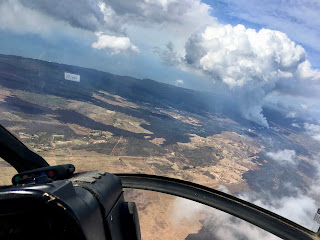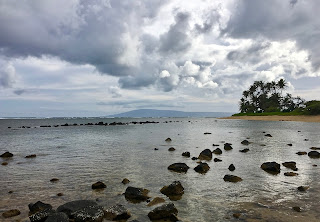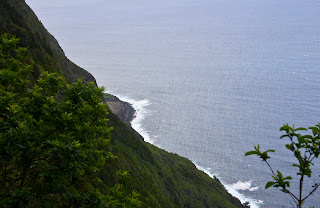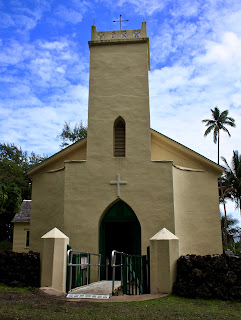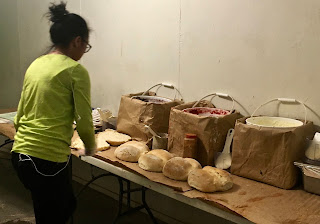Cracks appeared on residential streets and properties of the lower Puna District, and by May 3 some of those had grown into fissures that would leak and or spew lava.
Monday, August 6, 2018
Volcano in Suburbia
Ever since childhood, where I witnessed more than once that ubiquitous grade-school mock-up of a volcano that explodes with a mix of baking soda and vinegar and read with riveted focus multiple apocalyptic accounts of Pompeii’s destruction, volcanoes have piqued my curiosity, appealed to my sense of wonder, and frightened me utterly. Yet now I live on an island created by volcanoes and still operating in volcanic creation mode. In fact, the volcanic vent sponsoring the current eruption of Kilauea lava is located maybe ten miles or so from my house.
Here I am, the one suppressing constant willies during any visit with friends or family to Volcanoes National Park although I remain fascinated with all the science, history, and lore presented and observed while there. [At present the park is closed—since mid-May actually—and when it reopens, many of the landmarks and details recorded in my memory from previous visits will be radically changed or gone altogether.] Here I am, the one who cherishes every mile of distance between my abode and the park: maybe 20-25 of them “as the crow flies.” And here I am, the one who felt absolutely no disappointment when my realtor informed me that my mortgage company would not finance a home in lava zones 1 or 2.
Nevertheless, rather early Monday morning, April 30, I received a phone call from a church member notifying me that some people might be required to evacuate because Kilauea had shifted into imminent eruption mode and suggested that I review my “evacuation kit.” (A committee of church members had been assigned to contact as many church members as possible that morning.) At this point, volcano precautionary measures had not yet arrived at news-worthy status for radio and TV; that happened on Tuesday.
On Tuesday, May 2, the lava lake in the crater of Kilauea began to drop, and driving home from Hilo on Wednesday, May 3, I saw this plume rising on the horizon.
Cracks appeared on residential streets and properties of the lower Puna District, and by May 3 some of those had grown into fissures that would leak and or spew lava.
Cracks appeared on residential streets and properties of the lower Puna District, and by May 3 some of those had grown into fissures that would leak and or spew lava.
Thursday morning, May 4, while working in my yard—and sitting on a section of very volcanic rock—I heard and felt a significant earthquake: one that ranked as a 5.4, I learned later. But that was only a prelude for what awaited us. Just after noon, a much larger earthquake struck: 6.9 this time. Having spent seven years living in Japan, I became quite familiar with the rattle and shakes of earthquakes, some of them providing quite a jolt or pitch and sway. This one here in Hawaii Island on May 4 takes the top spot for all of it: strength, length, rattle, shake, skew, and breakage. I actually left the house before it finished. All pictures on the wall required straightening, and three pictures resting on shelves and against the wall fell over, breaking the glass on one when it took a second spill to the floor. Outside I have a 10,000 gallon catchment tank, and—remember, I had escaped my house before the earthquake finally ended—I suddenly realized it had begun making this sporadic, but rather rhythmic, sloshing sound. With closer examination, I saw water spill over the top on one side, followed by the sound of rolling water before then spilling over the opposite side, and repeat again. The pattern reminded me of my bathwater when I was a kid and sliding from one end of the tub to the other “to make waves.”
For the first ten days or so after opening, the fissures emitted noise that I could hear from my house. At night I would lie in bed listening to what sounded like distant thunder but from a storm stalled; it never advanced or retreated. The first night of that eerie fissure noise, I didn’t sleep well, creating all manner of images of advancing lava. I even reworked and augmented my collection of evacuation stuff the next day because the sounds unsettled me so. But then I grew accustomed to the dissonant music and didn't even notice exactly when it went silent.
An erupting volcano in the neighborhood prompts all kinds of new behaviors in addition to that first action of formulating evacuation plans: What about ash? What about bad air? What about acid rain? What about lava…well okay, for lava danger—because lava wins any sort of confrontation—you evacuate…always…and that is something a shield volcano (all volcanoes on-island are shield volcanoes) generally allows time for if one is paying any sort of attention to it. But those other possibilities that arise with an erupting volcano? I read and I listened and I attempted several different precautionary measures, some more successfully than others. A friend told me that water in catchment systems on this island with an active volcano is always a bit on the acidic side, something that can be mitigated to a certain extent by adding baking soda to it. My reading confirmed that statement, and following some amount guidelines I learned from my reading, I dumped into my catchment tank the contents of the two boxes of baking soda on hand, figuring I would buy more on my next foray into town for groceries and other supplies. I quickly discovered, though, that in Hilo and environs there was no baking soda available for purchase; the shelf space for baking soda—in food or cleaning aisles of multiple establishments—remained empty for at least the next two weeks. The other item that sold out quickly during this time was tarps big enough to cover a catchment tank—employed to prevent ash contamination of household water should an ash event occur. I shall not enumerate here my trials and travails with tarps, to include the placement of tarps over my catchment tank…considering my lack of height and my dogged desire not to be dependent if at all possible…and there was more than one placement attempt in this saga because I had enormous difficulty acquiring appropriately sized tarps and dabbled in various jerry-rigging ventures. It was not pretty! I ultimately abandoned the tarp experiment several weeks later because, due to the amount of rain we receive on the windward side of the island, a tarp over the tank became more of a liability than benefit. Due to the inordinate weight of puddled rainwater, removing the tarp proved to be an ugly endeavor as well—personal height and independent streak withstanding!
Fissure noise surrendered to expansive quantities of lava spewed furiously and continuously from mostly fissure number eight, and the lava glow lit a portion of the night sky in crimson and vermillion—a stunning spectacle for its mesmerizing beauty combined with its daunting creation story.
Pahoa Town by day.
Pahoa Town by night with the lava glow.
Lava glow from my street.
Fissure eight, just like over twenty other fissures in Kilauea’s rift zone, opened up on a level expanse of suburbia in early May. Soon it became Kilauea’s preferred lava exit point in this eruption. As the lava continued to spew, it created a cone that rose over 180 feet tall and sourced a snaking lava river that eventually found the ocean over eight miles away. Almost ten square miles of lower Puna is covered by this lava flow now, to include over 700 homes, agricultural land, lush rain forest, and shoreline tide pools. The lava flow has also added at least a mile of new land to the island.
The first week of July with my friend Camille I had the chance to take a helicopter tour of the eruption area. It was an amazing experience—beautiful but also awesomely humbling. These are photos taken during that tour:
As of Tuesday, July 31, the current Kilauea eruption has lasted longer than any previously recorded ones. Today, though, Fissure 8 has noticeably stilled its lava production. Has Kilauea completed her endeavor or is she taking a small break? No one yet knows.
Fissure 8, Sunday, August 5, 2018
APPENDIX: Volcano Vocabulary
Over these last weeks I’ve also increased my knowledge of the language of volcanoes. Before this eruption I had mastered the difference between pahoehoe lava and a’a lava: Pahoehoe lava has a smooth or “ropy” surface while a’a consists of free chunks of very angular pieces of lava. Pahoehoe lava designs contour line designs as it cools and a’a looks totally like something you would cross barefoot absolutely howling “ah-ah, ah-ah!”
Now, though, my vocabulary has expanded. Clinkering describes the sound “clinker” lava—a type of a’a lava, often brittle and breakable—produces when it shatters. Pele’s hair refers to the fine threads of volcanic glass formed when a spray of lava droplets cools rapidly in the air. Abrasive, it can cause irritation to skin and eyes. It can also cut you. Pele’s tears, jet black and often found on one end of a strand of Pele’s hair, are small pieces of solidified lava formed when airborne particles fuse into tearlike drops of volcanic glass. And then there is the lava bomb—a mass of molten rock larger than 2.5 inches in diameter, formed when ejected viscous fragments of lava cool into solid fragments before they reach the ground. I would be remiss not to include these atmospheric terms, too: Vog is volcanic smog—sulfur dioxide as well as other gases and particles emitted into the atmosphere by an erupting volcano. Laze, formed when lava enters the ocean and triggers a series of chemical reactions, is the steam cloud that rises above the entry area. Comprised of hydrochloric acid, other gases, and volcanic glass particles, it is hazardous.
Sunday, April 15, 2018
Molokai
I think my first awareness of the Hawaiian island of Molokai, the one used to locate a leper colony, came from my mother. She taught school on the island of Kauai in the early 1950s, and that colony, situated on the isolated Kalaupapa Peninsula from 1866-1969, was still in existence. My childhood memories are layered with songs and hula and stories and muumuus and leis from my mother's experiences in Hawaii. Molokai never headlined the Hawaiian moments she shared with her children, but I know it showed up a few times--maybe as an extension to a discussion of leprosy and lepers, one generated in reference to a scripture story we were reading as a family.
As an adult, my friend Tammy reconnected me to Molokai when she told me the story of Father Damien. On Netflix I found the 1999 movie, Molokai: The Story of Father Damien, based on Damien's experiences in Molokai. I watched it, transfixed--probably more for story than for cinema greatness, but the story moves me. You can watch the movie yourself, now on YouTube in its entirety, right here. (I know because I recently watched the movie again, this time on YouTube!)
When Tammy and I visited Hawaii around five years ago, we considered a quick jaunt to Molokai from Maui but couldn't make the side trip work with the rest of our vacation schedule. When I moved to Hawaii, a visit to the island of Molokai remained high on the list in my mind of places to go. Finally last month--March--my friend Camille and I met in Honolulu and took the quick flight to Molokai--ascend, down a quick drink, descend--on a small turbo prop that shuddered and bounced in the wind on its descent!
Molokai, Hawaii's fifth largest island, is 38 miles long and 10 miles across at its widest. With a little over 7,000 residents, many of them native Hawaiians, it has a rural vibe and a more traditional Hawaiian sensibility.
Once we arrived at the Molokai Airport just after the noon hour on a Friday, we picked up a rental car and lunched at a hamburger joint before heading to our vacation rental. Then, with drive-by reconnaissance of much of the island and a few stops at various beaches--all pretty and mostly bereft of other humans--we whiled away the afternoon.
This final photo was taken from the balcony of our vacation rental.
Although we had changed into our swimsuits in preparation for some beach time, the gusty day proved to be a bit chilly for any water play. We stocked up on breakfast items in Kuanakakai--the largest town, the hub of civilization on the island--ate dinner at Paddler's Restaurant and Bar, and returned to our vacation rental to prepare for Saturday's adventure: a mule ride down and up the highest sea cliffs in the world and a tour of the former leper colony in Kalaupapa.
Kalaupapa is isolated--maybe its foremost characteristic and the one that led to its designation in 1866 as the site for a leper colony. Virtually barricaded from the rest of the island by the highest sea cliffs in the world, the sea became its main access, but an access that could be dictated by those with the power and the wealth to accomplish it...or not. A steep, winding path, a little over three miles long, does exist on a portion of the expanse of sea cliffs, a path that can be hiked or done riding a mule. The hike is ranked as 4 out of 5 in difficulty, with 5 as the greatest amount of difficulty. Camille and I opted for the mule ride.
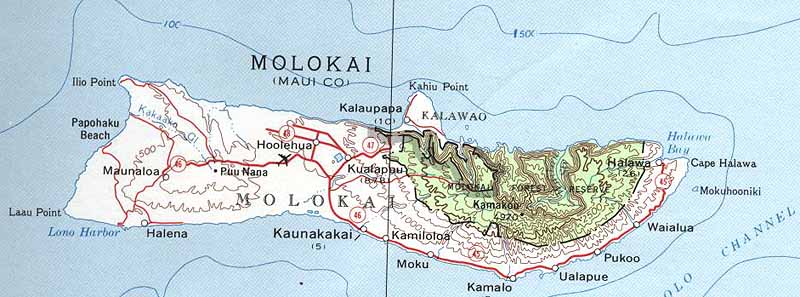
(Kalaupapa now has a tiny airport, too, so tourists can also arrive via air; tourists--and the number per day is limited--arrive on foot, on mule, or by plane. Nowadays a barge carries the "big" supplies to Kalaupapa once or twice a year; otherwise, supplies come via small plane or else by the physical effort of human or beast.)
With a 7:45am check-in for the mule ride, Camille and I arrived early on Saturday morning. Our two muleskinner guides matched the six tourists (yep, that's all because two mules were on loan to a movie set, so really the biggest number of tourists possible per day on the mule ride could be eight) with their mules and briefed them on mule-riding protocol. We did practice how to "control" our mules a bit before commencing the trek.
A girl and her cat: This is Nick, a kitten belonging to one of the muleskinner guides.
A girl and her mule, Deuce.
Camille and one of our guides.
The trek down was difficult, often uncomfortable on the body, stressful at moments, and absolutely amazing. Deuce liked to eat, and the two of us ultimately reached a viable working relationship--how to balance a time to chew and a time to move forward, especially once I realized which of the other mules provoked Deuce's competitive nature. The trek back up was much easier and faster, too! These next photos are from the trek itself, most of them from the ascent because taking pictures becomes so much easier when one doesn't have to constantly engage preventative measures to avoid a tumble over the head of one's mule.
The tour of the former leper colony and the current community on Kalaupapa was both fascinating and moving. Our guide had a personal connection to the community and a spiritual one, too, I think. In fact, he and his brother show up briefly in that 1999 movie. (The movie actually incorporated many members from the Kalaupapa community.) Funny and a great storyteller, his emotions hovered on the surface of all he shared and touched the hearts of his listeners.
These photos are from the tour of the former leper colony and the current Kalaupapa community.
Father Damien's church.
Father Damien's grave in the churchyard.
Many of the lepers were buried in unmarked graves.
The Kalaupapa Airport.
The Kalaupapa Port and looking toward the sea cliffs.
The sea cliffs from Kalaupapa. The trail we took on the mules winds through these.
Saturday evening, after showers and dinner, Camille and I decided to participate in Molokai's hot bread run. Yeah, that's a major thing in the Molokai nightlife scene! On an island where only two or three establishments have liquor licenses, legend has it that Kanemitsu's began as a bar and solved its problem of drunk patrons hanging around all night by serving hot bread to soak up all the ingested alcohol. The bar eventually evolved into Kanemitsu Bakery, and now around 8:00 most nights the bakery sells hot bread with toppings to locals and tourists in-the-know. However, the night-time hot bread is not purchased inside the bakery per se. Instead, you wander down this dark alley at the side of the bakery--definitely seedy in aura and portending great danger...except this is Molokai!--until you find this:
In case you can't read it, there is a sign that says "Hot Bread" at the opening of this corridor.
At the back of the corridor is a window where you place orders and pay up.

The bread is served hot, fresh from the oven, as an entire loaf sliced horizontally through the middle and slathered with desired topping or a combination thereof: butter, cream cheese, cinnamon, blueberry jam, and strawberry jam.
Assembly line style preparation of sorts.
Camille and I ordered one with butter and cinnamon--warm, sweet, and a total carb overload! We didn't even consume half the loaf but concluded that if ever there were a second Molokai hot bread run in our lives, we would order one with butter, cinnamon, and cream cheese!
Sunday, before our afternoon departure for Honolulu, we undertook a bit more drive-by exploration of the island. On a deserted highway with a sea-facing approach we observed two humpback whales frolicking off-shore--a splendid image for memories of an ending.
Subscribe to:
Posts (Atom)









